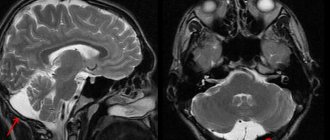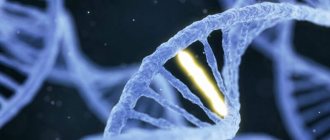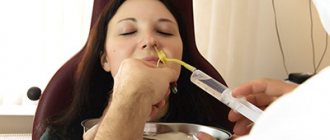Why does allergies occur?
Anyone who suffers from allergic reactions sooner or later wonders why allergies occur. With an allergy, a certain substance from the outside - an allergen - when it enters the body, is perceived by our immune system as a foreign agent - an antigen . In defense against the antigen, antibodies (immunoglobulins, lymphokines) are produced. When the same allergen antigen enters the body again an allergic reaction (a reaction of both protection and damage to one’s own cells/tissues at the same time). Depending on the amount of allergen antigen that enters us, and the body’s sensitivity to this allergen, allergies can manifest as mild symptoms (runny nose, itching, allergic conjunctivitis), or have serious consequences for the entire body (anaphylactic shock, Quincke’s edema).
Types of allergic reactions
All allergens can be divided into two main groups:
- Exoallergens - all environmental factors that give impetus to the development of an allergic reaction (infectious allergens - bacteria, viruses; non-infectious - plant pollen, food allergens, animal hair, dust, pesticides, aeropollutants)
- Endoallergens are factors in the internal environment of the body that accompany the development of an allergic reaction.
Also, all allergic reactions can be divided into 2 large groups:
- true
- false or pseudoallergic
The main sign of pseudoallergy is that the severity and time of manifestation of the first signs of the disease depend on the amount of a particular product containing the allergen, as well as on the concentration of these substances (i.e., the process is dose-dependent).
For example, if you eat a kilogram of tangerines/strawberries, then any healthy person will show signs of pseudo-allergy (skin symptoms, itching, rhinitis, conjunctivitis). In a true allergic reaction, the process is dose-independent. Those. One molecule of the allergen is enough for the allergic reaction to go into full swing. For example, it is enough to lick a tangerine/strawberry to trigger an allergic reaction.
The types of allergic reactions are also divided into immediate type reactions and delayed type allergic reactions. If allergic reactions between the allergen and body tissues occur immediately, then they are called immediate-type reactions , and if after a few hours or even days, then these are delayed-type allergic reactions.
There are 4 types of allergic reactions:
- Allergic reaction type I, or immediate type reaction (anaphylactic, atopic type). It develops with the formation of antibodies belonging to the class IgE and IgG4, which are fixed on mast cells and basophilic leukocytes. When these antibodies are combined with an allergen, mediators are released: histamine, heparin, serotonin, platelet-activating factor, prostaglandins, leukotrienes, etc., which determine the clinical picture of an immediate allergic reaction that occurs within 15–20 minutes.
- An allergic reaction of type II, or a cytotoxic type reaction, is characterized by the formation of AT related to IgG and IgM. This type of reaction is caused only by antibodies, without the participation of mediators, immune complexes and sensitized lymphocytes. ATs activate compliment, which causes damage and destruction of body cells, followed by phagocytosis and their removal. It is the cytotoxic type that causes the development of drug allergies.
- Allergic reaction type III, or immune complex type reaction (Arthus type), occurs as a result of the formation of circulating immune complexes, which include IgG and IgM. This is the leading type of reaction in the development of serum sickness, allergic alveolitis, drug and food allergies, and a number of autoallergic diseases (SLE, rheumatoid arthritis, etc.).
- Allergic reaction of type IV, or delayed type allergic reaction (delayed hypersensitivity), in which the role of AT is performed by sensitized T-lymphocytes, which have specific receptors on their membranes that can interact with sensitizing Ags. When a lymphocyte combines with an allergen, mediators of cellular immunity are released - lymphokines, which cause the accumulation of macrophages and other lymphocytes, resulting in inflammation. Delayed reactions develop in a sensitized organism 24–48 hours after contact with an allergen. The cellular type of reaction underlies the development of viral and bacterial infections (tuberculosis, syphilis, leprosy, brucellosis, tularemia), some forms of infectious-allergic bronchial asthma, rhinitis, transplantation and antitumor immunity.
Allergy
08.08.2019
If you believe the advertising, allergies are one of the biggest problems of humanity. And this is true, in contrast to what we will hear next: just take a “magic” pill and the disease will go away. But in real life everything is not so simple.
It turns out that allergies are not only itching, watery eyes, sneezing and a “fountain” from the nose, but also high fever, nausea, diarrhea and general weakness. Surprisingly, when all the white light is not nice and even the walls are irritating, our nervousness can also be a manifestation of allergies. And although this problem has been known to people since the construction of the pyramids, over the past two decades the incidence of allergies has increased 3-4 times, and today more than 25% of the world's population suffers from various manifestations of it. Some authors cite even more depressing figures - allergies plague up to 60% of residents of megacities! So, the symptoms of the disease are diverse, and the causes are countless. The body can react unpredictably to everything that surrounds us - plants, insects, house dust, animal hair, household chemicals. So what is this problem and how to deal with it?
Allergy,
according to one of the modern definitions, it is an excessive reaction of the human body’s immune system to foreign substances
(allergens)
.
The immune system is our “special forces”, responsible for the constancy of the internal environment of the body. All “strangers” that penetrated it from the outside (bacteria, viruses, parasites), or “terrorists” disguised as their own, that appeared during life (atypical cells), must be neutralized. The immune system has the ability to distinguish “self” from “foreign” and take measures to destroy it. A considerable “army” of “fighters” ready for defense is responsible for order in the body: entire organs (thymus, spleen), islands of lymphoid tissue (lymph nodes, pharyngeal lymphoid ring, intestinal nodes, etc.), blood cells (various types of lymphocytes) and antibodies (special protein molecules).
Normally, when a “foreigner” (for example, a virus) first enters the body, the immune system reacts by analyzing and remembering its structure, and then produces antibodies that remain in the blood plasma. The next arrival of the same antigen causes an immediate attack by pre-synthesized antibodies, which quickly neutralize the “uninvited” guest, and the person does not get sick. In addition to antibodies, T-lymphocytes, which are capable of secreting enzymes that destroy the antigen, also participate in the battle. They are called “T-killers”.
An allergic reaction is not fundamentally different from the normal response of the immune system to an antigen. The difference lies only in the inadequacy of the relationship between the strength of the reaction and the cause that causes it.
Under normal conditions, the body ignores the effects of most substances that enter it. Refractoriness is what doctors call this “ignore”.
So why do some people develop strong reactions to things that others simply don't notice? Unfortunately, there is no clear answer to this question. The sharp increase in the number of sensitized people in recent decades is partly due to the huge number of new compounds they encounter in everyday life.
The most common exogenous allergens
Food
– milk, eggs, chocolate, honey, citrus fruits, cereals, seasonings, preservatives, food coloring.
Household
– house, hotel, library dust and some of its components (microscopic dermatophagoid mites, microorganisms, etc.), dander and hair from cats, dogs, horses and other animals, feathers and down (including from pillows), dry fish food , poultry excrement, cockroaches, mold spores (especially in damp areas).
Contact
– detergents, washing powders, polishes, cosmetics, products made from synthetic materials.
Pollen
– pollen of trees (birch, aspen, hazel, etc.), cereals (rye, corn, sunflower, etc.), weeds (ragweed, dandelion, wormwood, etc.), meadow grasses (cocksfoot, timothy, ryegrass and etc.).
Chemical
– low molecular weight (nickel, chromium, mercury, dinitrochlorobenzene, etc.) and high molecular weight chemicals (varnishes, paints, polymers).
Insect
– poisons and allergenic substances of insects.
Medicinal
– any medicine can be an allergen.
In addition to external allergens, there are allergens of internal origin (endoallergens). With injuries, infections, exposure to toxic substances or radiation, the normal structure of tissues is disrupted, and the body perceives them as foreign, reacting with the formation of antibodies.
All types of allergic reactions are based on a single mechanism, in which several stages
.
Immunological stage
This is the first meeting of the body with an antigen and the production of antibodies to it - sensitization. The reaction occurs with repeated and all subsequent intakes of the antigen. Antibodies attack an antigen to destroy it and form antigen-antibody complexes.
Pathochemical stage
The resulting immune complexes damage special mast cells found in many tissues. Inflammatory mediators (histamine, bradykinin, serotonin, etc.) contained in these cells are activated and released into the general bloodstream.
Pathophysiological stage
This is the result of the effect of inflammatory mediators on organs and tissues. Various external manifestations of allergy occur - spasm of the bronchial muscles, increased intestinal motility, gastric secretion and mucus formation, dilation of capillaries, the appearance of skin rashes, rhinitis, etc.
Since allergies can occur in different ways, the following types of allergic reactions are distinguished.
Type I – anaphylactic (immediate type)
Reactions of interaction of immunoglobulins (antibodies) of group E (IgE) and G (IgG) with an external antigen. The resulting complex settles on the membranes of mast cells, releasing large amounts of histamine. Time of occurrence of the reaction: from several minutes to several hours after the penetration of the antigen into the body. Examples: anaphylactic shock, Quincke's edema, urticaria, atopic bronchial asthma, allergic rhinitis, food allergies in children.
Type II – cytotoxic (or cytolytic)
Reactions of interaction of immunoglobulins of groups M and G with the body’s own cells, perceived by the immune system as antigens. As a result, cells are destroyed and die. Time for development of the clinical picture: up to several hours. Examples: hemolytic anemia, hemolytic jaundice of newborns due to Rh conflict (destruction of red blood cells), thrombocytopenia (platelets die), complications during blood transfusion, administration of drugs (toxic-allergic reaction).
Type III – immunocomplex (Arthus phenomenon)
Immune complexes of antigen molecules and antibodies of groups G and M are deposited on the inner walls of the capillaries and cause their damage. Reaction time: from several hours to several days. Examples: serum sickness (immune response to serum administration), glomerulonephritis, rheumatic diseases, allergic dermatitis.
Type IV – late hypersensitization (delayed type)
Time for reaction development: a day or more after the antigen enters the body. The reactions occur with the participation of T-lymphocytes (hence another name for them - cell-mediated). The attack on the antigen is provided not by antibodies, but by specific clones of T-lymphocytes that have multiplied after previous arrivals of the antigen. Lymphocytes secrete active substances - lymphokines, which can cause inflammatory reactions. Examples: contact dermatitis, bronchial asthma, rhinitis.
Allergic reactions are also divided according to the nature of their course - seasonal and year-round.
In addition to true (specific) allergies, there are conditions that are clinically very similar to allergies, but are not. The release of histamine and other inflammatory mediators does not occur as a result of sensitization of the body with specific antigens, but as a result of some other problems in the body, for example, a decrease in the antitoxic function of the liver during its diseases. Such reactions are called pseudoallergic (nonspecific).
Many authors classify allergic reactions according to clinical forms
.
1. Allergic dermatoses (allergic skin diseases):
a) atopic dermatitis (severe itching, redness and swelling of the skin) - occurs in children;
b) urticaria (skin itching, sudden appearance and rapid disappearance of blisters on the skin and/or mucous membranes) - more common in adults;
c) angioedema of Quincke (limited swelling of the skin, subcutaneous tissue and mucous membranes, dangerous because if it spreads to the respiratory tract, suffocation can occur).
2. Allergic rhinitis.
3. Allergic conjunctivitis.
4. Hay fever (hay fever, spring catarrh) is an allergic rhinitis caused by plant pollen.
5. Bronchial asthma.
6. Serum sickness is a generalized allergic reaction to the administration of medications, in particular to foreign serum proteins.
7. Anaphylactic shock is a reaction of the whole body to contact with an allergen. It is characterized by initial excitation followed by depression of the central nervous system, bronchospasm and a sharp decrease in blood pressure. This is the most severe manifestation of allergies.
Factors contributing to the development of allergic reactions
Ø Presence of hereditary predisposition.
Ø Sensitization in early childhood (including in utero).
Ø Exposure to tobacco smoke.
Ø Exposure to industrial wastes that contribute to sensitization.
Ø Eating large amounts of sweet foods. Such food increases the severity of allergic reactions.
Ø Emotional stress.
Ø Periods of hormonal changes in the body: puberty, pregnancy, menopause, menstruation.
Ø Increased insolation.
Any manifestation of an allergy requires consultation with a doctor to identify the allergen, choose the right treatment tactics and prevent recurrent allergic reactions.
However, the presence of certain symptoms in a patient is a reason to urgently seek medical help.
Allergy symptoms that threaten the health and life of the patient
Ø Shortness of breath, difficulty breathing, disorders of the nervous system, a sharp drop in blood pressure, attacks of suffocation.
Ø Signs of laryngeal edema: hoarse voice, barking cough, difficulty breathing.
Ø Spread of swelling to the upper half of the face.
Ø Manifestations of severe anxiety, feelings of fear, severe weakness, increased motor activity.
Ø Abdominal syndrome – nausea, vomiting, abdominal pain of varying intensity.
Ø Allergic rhinitis is accompanied by bloody nasal discharge or fever and purulent nasal discharge.
Ø The emergence of new manifestations of allergies during treatment.
Ø Manifestations of allergies do not decrease within 24 hours after the start of treatment or recur sporadically.
Contact us at the Affordable Doctor clinic.
Affordable doctor: AFFORDABLE QUALITY PRIVATE MEDICINE!
Subscribe to the Facebook and Telegram page to follow the continuation of the CRIB SHEET FOR PATIENTS section.
Yuri CHERTKOV, doctor, business coach, director
leave a comment
How to provide first aid for an allergic reaction
We figured out why allergies appear. But what to do if you still couldn’t protect yourself. If you experience itching or a burning sensation on your skin, a stuffy nose or symptoms of a sore throat, or you start sneezing very often, then you probably have an allergic reaction to some irritant. Follow procedures to help cope with the attack.
- It is necessary to rinse the area of skin or nasal cavity where contact with the allergen occurred with warm water.
- If the cause of the allergic reaction is an insect bite, make sure there is no sting in the wound
- Try to get rid of the allergen if it is still around. Move flowers or pets to another room and try to limit your contact with them
If after all the measures the condition does not improve or, moreover, gets worse, call the ambulance service or go to the hospital yourself.
If you are not experiencing an allergic reaction and need to provide first aid to another person, use the following recommendations:
- Lay the victim on the floor and elevate his legs. This way blood will flow from the legs to the body
- If an allergy occurs to medications or any food, then you need to rinse the stomach and give the victim activated charcoal. Also, if possible, give an enema and do not allow the victim to drink until the stomach is washed.
- If a person has lost consciousness, place him on his side to prevent the tongue from retracting. Monitor your pulse and breathing. Perform artificial respiration and chest compressions if there are no signs of breathing or pulse. Next, urgent hospitalization in a hospital !
Allergies: types, manifestations, treatment
Back to list Previous article Next article
16.06.2021
Tags:
allergies, dermatitis
5/5 — (1 vote)
Allergies , common in children and adults, are altered, aggressive reactions of the immune system to certain substances called allergens.
Allergies can be caused by: plant pollen, mold, animal dander, insect bites, dust, household chemicals, cosmetics, synthetic substances, antibiotics, medications, foods with chemical additives, fruits, nuts, seafood, cow's milk protein. In many cases, in ordinary life, most people do not have a reaction to these substances - irritants, because The immune system is adapted to many substances and works with a normal reaction.
But, in situations of change, deterioration of the environment, with frequent colds, with an unhealthy diet with a large amount of waste, indigestible foods and a small amount of fiber and other substances that nourish our beneficial microflora, if the composition of the intestinal microflora is disrupted, the immune system is disrupted.
Allergic reactions can develop according to any type of hypersensitivity: 1. immediate type - Quincke's edema, anaphylactic reaction, urticaria, bronchospasm, developing within a few minutes to 30 minutes, or less often up to 2-3 hours, after contact with the allergen, more often this is a reaction for medicines and chemicals. 2. delayed type - the reaction develops 48-72 hours after contact with the allergen substance.
Types (manifestations) of allergies: 1. hay fever 2. rhinitis 3. conjunctivitis 4. dermatitis 5. urticaria 6. food allergy.
The development of allergies can be manifested by: lacrimation, itching, redness of the eyes, runny nose, sneezing, nasal congestion due to swelling of the mucous membranes, difficulty breathing, bronchospasm, itchy skin, rashes on the skin.
In providing assistance with allergies it is necessary: 1. eliminate contact with the allergen 2. remove allergocomplexes, toxic substances 3. antihistamines 4. further - symptomatic assistance for specific disorders of the organs.
Of course, if this is an immediate reaction, then call an ambulance, emergency help.
But, most often, gradual sensitization develops, hypersensitivity to a certain substance, and then you need to be examined by an allergist-immunologist, identify the cause, the substance that causes the allergy, and undergo comprehensive treatment in accordance with the identified substances and disorders in the organs. In recent decades, frequent skin toxic symptoms have appeared for various nutrients, components, products and dishes, due to the large number of chemical additives and stabilizers in their composition.
It has long been known that the immune system, reactions of immune cells, adaptation to toxic substances of various natures are directly related to the state of the intestinal microflora, with the activity of beneficial microflora on human mucous membranes. For many years, allergists and immunologists have been using probiotics, or symbiotics, in complex treatment.
In the complex treatment of allergies and skin disorders, allergists have been using Normoflorins for many years.
For atopy and skin disorders, you need to take only normoflorin D in the first three monthly courses, in a dose according to age, according to instructions, twice a day, morning and evening, 20 minutes before meals, without dilution, breaks between courses of normoflorin 1-2 month.
For hay fever, you need to take Normoflorin D a month before flowering, in early spring or early summer, depending on the timing of flowering of allergenic plants, courses can be up to 4-6 or 8 weeks, depending on the duration and severity of allergic manifestations.
In the first 10-14 days of each course of normoflorins, it is necessary to take a sorbent - polysorb or enterosgel or white coal, twice a day, during the day between meals and at night, in the morning the sorbent is not needed, in the morning normoflorins.
Back to list Previous article Next article











